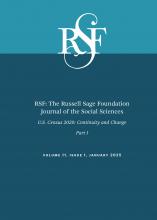Research Article
Open Access
Who Is Black on the Block? Black Immigrants and Changing Black Neighborhoods
Nima Dahir
RSF: The Russell Sage Foundation Journal of the Social Sciences January 2025, 11 (1) 110-131; DOI: https://doi.org/10.7758/RSF.2025.11.1.06
Nima Dahir
aAssistant professor and provost’s fellow in sociology at the Ohio State University, United States

REFERENCES
- ↵
- Candipan, Jennifer, and
- Michael M. Bader
- ↵
- Card, David
- ↵
- Charles, Camille Zubrinksy
- ↵
- Charles, Camille Zubrinksy
- ↵
- Clark, William A. V
- ↵
- Crowder, Kyle D
- ↵
- Crowder, Kyle D.,
- Matthew Hall, and
- Stewart E. Tolnay
- ↵
- Cutler, David M.,
- Edward L. Glaeser, and
- Jacob L. Vigdor
- ↵
- Ellen, Ingrid Gould
- ↵
- Ellis, Mark, and
- Richard Wright
- ↵
- Farley, Reynolds, and
- William H. Frey
- ↵
- Freeman, Lance
- ↵
- Frey, William H
- ↵
- Frey, William H
- ↵
- Frey, William H
- ↵
- Frey, William H., and
- Reynolds Farley
- ↵
- Hamilton, Tod G
- ↵
- Hamilton, Tod G
- ↵
- Holloway, Steven R.,
- Richard Wright, and
- Mark Ellis
- ↵
- Hwang, Jackelyn
- ↵
- Iceland, John
- ↵
- Iceland, John
- ↵
- Iceland, John,
- Gregory Sharp, and
- Jeffrey M. Timberlake
- ↵
- Kasinitz, Philip
- ↵
- Krysan, Maria
- ↵
- Krysan, Maria,
- Mick P. Couper,
- Reynolds Farley, and
- Tyrone A. Forman
- ↵
- Krysan, Maria, and
- Kyle Crowder
- ↵
- Krysan, Maria, and
- Reynolds Farley
- ↵
- Kye, Samuel H., and
- Andrew Halpern-Manners
- ↵
- ↵
- ↵
- Logan, John R., and
- Charles Zhang
- ↵
- Manson, Steven,
- Jonathan Schroeder,
- David Van Riper,
- Tracy Kugler, and
- Steven Ruggles
- ↵
- Pais, Jeremy F.,
- Scott J. South, and
- Kyle Crowder
- ↵
- Parisi, Domenico,
- Daniel Lichter, and
- Michael Taquino
- ↵
- ↵
- Pierre, Jemima
- ↵
- Saiz, Albert, and
- Susan Wachter
- ↵
- Santiago, Anne M
- ↵
- Scopilliti, Melissa, and
- John Iceland
- ↵
- South, Scott J., and
- Kyle D. Crowder
- ↵
- Tamir, Christine
- ↵
- Taub, Richard P.,
- D. Garth Taylor, and
- Jan D. Dunham
- ↵
- Taylor, Marylee C
- ↵
- Tesfai, Rebbeca
- ↵
- Tesfai, Rebbeca
- ↵
- Tesfai, Rebbeca,
- Matt Ruther, and
- Janice Madden
- ↵
- U.S. Census Bureau
- ↵
- U.S. Census Bureau
- ↵
- U.S. Census Bureau
- ↵
- Waldinger, R
- ↵
- Waters, Mary C
- ↵
- Waters, Mary C
- ↵
- White, Michael J., and
- Jennifer E. Glick
- ↵
- Wilson, William Julius, and
- Richard P. Taub
- ↵
- Wooldridge, Jeffrey M
- ↵
- Wright, Richard, and
- Mark Ellis
- ↵
- Zhang, Wenquan, and
- John R. Logan
In this issue
Who Is Black on the Block? Black Immigrants and Changing Black Neighborhoods
Nima Dahir
RSF: The Russell Sage Foundation Journal of the Social Sciences Jan 2025, 11 (1) 110-131; DOI: 10.7758/RSF.2025.11.1.06
Jump to section
Related Articles
- No related articles found.
Cited By...
- No citing articles found.





